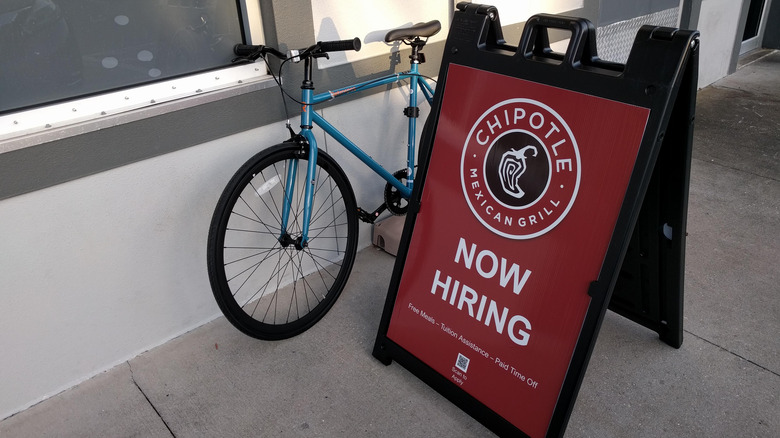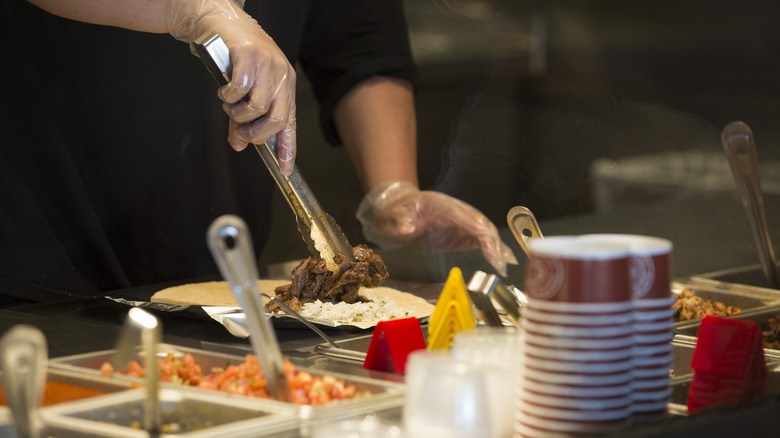Why Chipotle Thinks Its Employees Need To Work Faster
If you're a new Chipotle fan, you aren't alone. In 2021, Chipotle recently saw its highest worldwide sales on record: $7.55 billion (per data analytics platform Statista), thanks partially in part to locations with drive-thru lanes. If you're a longtime Chipotle fan, though, you definitely aren't alone. Chipotle saw its record-high year for in-store sales volume during the 2013-2014 market year, reports QSR, when restaurants were reportedly fulfilling as many as 30 in-store orders every fifteen minutes. Even though digital ordering is a much larger enterprise now than it was in 2013, Chipotle is making new efforts to return in-store order fulfillment to its former pace, too.
Despite record inflation (9.1%) putting consumer discretionary spending at an all-time low, according to Nasdaq, Chipotle is defying the odds by outperforming competitors and demonstrating consistent year-over-year growth (10% in Q2 2022 alone). Now, Chipotle is ready to expand bigger than ever. To speed up the ordering process, Chipotle installed new touchless POS systems, via QSR. In March, the restaurant chain began testing a robot called "Chippy" to make and season tortilla chips, per CNBC. But the brunt of the work is falling on the backs of employees, who are the real secret to Chipotle's envisioned success is that employees need to work faster, reported CEO Brian Niccol to CNBC.
Chipotle is hiring new employees -- then speeding up the pace
Even though the days of breakneck order-fulfillment speed in 2013 are nearly a decade in the past now, the fast food giant is far from hurting for sales. Chipotle's current average-unit volume (AUV) is $2.8 million (a whopping 39% of which comes from online orders), but Niccol predicts Chipotle will soon reach $4 million systemwide (via QSR). A restaurant's AUV, explains Law Insider, is its average unit volume, which is found by dividing total yearly sales by the number of store locations. But these good-looking numbers are the result of an initiative last year to hire a new fleet of employees and curb the restaurant's labor shortage.
In May 2021, via an official press release, Chipotle announced that it would be officially increasing average hourly wage to $15 by the end of June. Per the increase, employee starting wages would range between $11-$18 with the potential to advance to the "Restaurateur" position in just 3.5 years for an estimated annual salary of $100,000. The end goal of this push was to attract an additional 20,000 employees to Chipotle locations across the country. Once the restaurant chain was adequately staffed, its new obstacle was learning how to handle rapid, exponential growth with a workforce of new, relatively inexperienced employees.
Chipotle's CEO says workers just need to speed up
Niccol stated to QSR, "We're confident that if we can get our team members to understand what it means to be, call it, rush-ready in their places and ready to go, there's no reason why we can't get back to those high-20s, low-30s on a per 15-minute basis." He continued, "A lot of these folks haven't experienced how fast the line can move. So I think in some cases, folks think they're moving pretty quick when in fact we could be moving a lot faster."
While this might be music to investors' ears, anyone who has ever worked in the food service industry might find the comment a little concerning. Earlier this year, Whole Foods turned heads when it implemented surveillance systems to track employee productivity, even monitoring how quickly they respond to notifications and fulfill online orders (via Insider). Earlier this month, Chipotle Mexican Grill itself faced union busting allegations for closing a store location within weeks after employees filed a petition to unionize (via The Wall Street Journal). Admittedly, a ship full of experienced sailors might sail a little more smoothly, but "work faster" hardly seems like a sustainable prescription for long-term commercial success — especially if the restaurant has already dealt with nationwide staffing issues.


